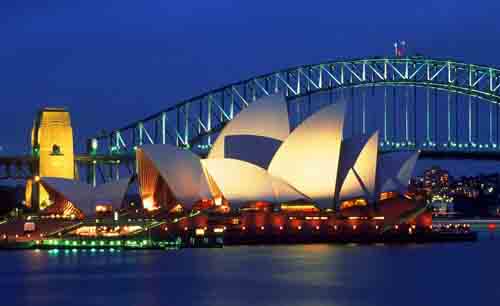

Migrants in Australia: the promised land
Nancy Liu arrived in Sydney from China as a "skilled immigrant" with an economics degree 14 years ago. With her husband, she set up a business consultancy in the suburb of Hurstville, once an Anglo-Celtic working-class stronghold. Since then, Chinese investment has transformed it: most of its shop signs are now in Chinese. Last year, Ms Liu was elected Hurstville's deputy mayor.
Ms Liu was a forerunner of a new wave of Chinese immigrants to Australia's oldest and biggest city. Hong Kong once supplied most of Australia's Chinese settlers, but over the past few years the pattern has shifted. Now it is the rising middle classes from mainland China who go there, looking for a cleaner, more relaxed lifestyle. About 4% of Sydney's 4.6m people were born in China. Hurstville's China-born population is about a third of its total and almost half its residents claim Chinese ancestry.
Sydney's first Chinese immigrants arrived as farm workers in the 1840s. The gold rush a decade later drew more. "Celestial City: Sydney's Chinese story", an exhibition at the Museum of Sydney, shows what happened next. By the 1880s, political fears of a "Chinese invasion" sparked anti-Asian immigration laws known as the White Australia policy, which lasted well into the 20th century.
But China's emergence as Australia's biggest trading partner, and its largest source of foreign university students, has revolutionised the relationship. In the fiscal year 2011-12, more than 25,000 Chinese people obtained permanent residence in Australia. Most of them were from the new middle classes. Then in late 2012 Australia launched a "significant investor" visa, aimed at China's super-rich. To get one, people need A$5m ($4.6m) to sink in "qualifying" investments. After investing for four years, successful applicants can apply for permanent residence.
The visas are called "subclass 188" and "subclass 888". As the number eight represents luck and prosperity in Chinese culture, the visa's main target is obvious. More than 90% of 702 applicants so far have been Chinese.
Many of the émigrés are media-shy. But their influence is visible in Chatswood, another formerly Anglo-Australian suburb. Towers of apartments, many owned by Chinese immigrants, now overlook the Edwardian-era stone and timber bungalows. Shops on the main street are crammed with Chinese noodles and vegetables, and Mandarin is the chief language among shoppers. Stacks of Chinese newspapers outnumber English ones.
Yan Zhang, who settled in Sydney after studying at Macquarie University, orders a lunch of pork dumplings at the New Shanghai restaurant. He reckons the new wave of middle-class Chinese immigrants, who arrive with residence already granted, come to Australia for the same reasons he did. "They want to make life more enjoyable and more secure," he says. "If I'd returned to China, I'd have had to be more selfish to survive."
澳大利亚——移民乐土
据《经济学人》报道,14年前,作为一个拥有经济学学位的“专业技能型移民”,刘女士(南希)从中国奔赴至澳大利亚。她同她的丈夫一起在赫斯特维尔的郊区成立了一个商业咨询公司,而那里曾是凯尔特工作阶级的聚集地。之后,中国投资者改变了这一状态,现在,那里大多数的商店符号都是汉字。去年,刘女士选举成为赫斯特维尔副市长。
刘女士是新掀起的中国移民到澳大利亚古老大城市浪潮中的先行者。香港曾向澳大利亚提供了大部分的中国居民,但就过去几年来看,形势已经改变。现在,日益增长的中国大陆中产阶级为了更干净舒适的生活,移民至澳。悉尼460万人口中有4%是中国移民。赫斯特维尔的中国移民则占据了其总人口数的三分之一,而接近一半的居民有着中华血统。
悉尼的第一批中国移民是19世纪40年代来澳的农民。十年后的淘金热则吸引了更多的人前往。悉尼博物馆开展了主题为“人间天堂:悉尼的中国人的故事”的展会,叙述了后续故事。到了19世纪80年代,政治上提出“中国式入侵”的恐惧论,触发了反亚洲移民政策,也就是白澳政策。这一政策直到20世纪才被取消。
中国已新兴成为澳大利亚最大的贸易伙伴,以及最多来澳大学留学生的来源地,这一切都彻底改变了两国关系。在2011年至2012年的财政年度间,超过2.5万的中国人取得了澳大利亚的永久居住权。其中,大部分都是年轻的中产阶级。2012年年末,澳大利亚针对中国的顶级富豪发行了“重要投资者”签证。申请此签证的人需要在澳投资500万澳元才能获得资格。而在连续四年的投资之后,成功的投资者可以申请永久居住权。
该签证被称为188类别和888类别签证。因为数字8在中国文化中代表着好运和发达,该签证的目标人群就显而易见了。截至目前,702位申请者中有90%是中国人。
许多移民者是躲避媒体的。但他们对查茨伍德区的影响却是引人注目的,而那里之前是英国侨民聚集地。中国移民居住的高层公寓现如今俯瞰着英国人的木质平房。主街上的商店里堆满了中国面条和蔬菜,普通话则成为了店员们的主要语言。成摞的中文报纸的数量远超出了英文报纸。
张岩(音)在麦考瑞大学就读之后就定居在悉尼了。他在新上海餐馆订了一份猪肉水饺作为午饭。他认为新兴的中国中产阶级移民来澳的原因同他一致,他们在获得合法居住权后到来。“他们都希望更享受、更安全的生活,”他说。“如果回国的话,我可能会为了生存而变得更自私。”
Copyright ©1999-2018
Chinanews.com. All rights reserved.
Reproduction in whole or in part without permission is prohibited.